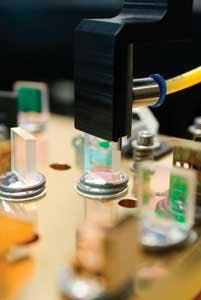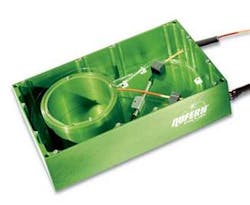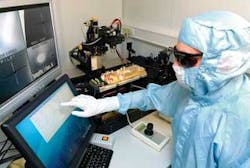STUART WOODS AND TOBIAS PFANZ
Fiber-laser technology has moved from a “niche play” in 2002 to a mainstream laser technology today-but what about diode-pumped solid-state laser sources? While in the past five years diode-pumped solid-state (DPSS) lasers may not have progressed far regarding performance specifications, they have certainly progressed in how they are manufactured, resulting in a positive impact on performance.
Coherent has developed a unique mounting mechanism for DPSS laser-cavity optics that delivers the requisite performance/cost characteristics, as well as enabling robotic-assisted assembly methods for high unit-to-unit consistency (see Fig. 1). Common industrial laser-marking applications require a robust light source, as well as superior performance in terms of pointing stability, high beam quality (low M2), and low noise. This performance must be reliably maintained across a wide range of different operating temperatures and in demanding industrial manufacturing environments. At the same time, these marking applications are extremely cost sensitive, so the laser must be economically fabricated.
Fiber lasers: labor intensive
Fiber lasers are made totally of optical fiber-a long, thin, glass fiber. This fact is both a strength and a weakness. Because the fiber itself is slightly larger than the size of a human hair, much of what goes into the manufacturing of a fiber laser is the handling and packaging of the fiber.
In its basic form, a fiber laser is two fiber Bragg gratings, a length of active fiber, and a method for coupling light from a multimode diode source into the active fiber. The latter can typically come with the addition of another component called a combiner. These five components are spliced together-fiber Bragg grating, combiner, active fiber, combiner, and finally another fiber Bragg grating (see Fig. 2).Today, this fiber-laser configuration-particularly for marking applications-can take on another form called a master-oscillator power amplifier (MOPA). Instead of the fiber Bragg gratings at the start, a single-mode laser diode is followed by one or two power amplifiers. These amplifiers are made up of the same active fiber and combiners from the first example.
To make these two basic architectures robust enough for industrial applications, it becomes a question of packaging. Strain and thermal isolation are the key elements that need to be managed in a fiber-laser system. Strain can cause the fiber to change refractive index, which can then affect the mode properties of the laser, while thermal isolation is key to making the fiber coatings and splices last.
Because the fibers are long and thin, any heat released during the lasing process is radiated over the entire length of the fibers; therefore, in the case of the active fiber, it becomes necessary to wind the fiber onto a spool or embed the fiber in a thermal compound to facilitate withdrawal of the heat from the full length of the fiber. Even with the MOPA architecture that begins with a single-mode diode laser spliced to the amplifier, the active fiber of the amplifiers must be thermally isolated in this way.
The most amazing characteristic of fiber lasers may not be their performance but that all the steps described above are done by hand: fiber is wound into a package and the laser is assembled by hand. Typically, in low-power fiber lasers the majority of the cost is not the diodes, but the assembly and mechanical elements. It is hard to envision a future when even the most basic fiber laser would not involve a significant amount of manual handling in the assembly process.
DPSS lasers: monolithic mounting, robotic assembly
Diode-pumped solid-state Q-switched, lasers utilize a cavity that is defined by several discrete optical elements such as mirrors and dichroic filters. Traditionally, these cavity optics have been held in adjustable mounts with screw-driven angular adjustments. The adjustment screws are locked in place once the laser has been aligned. This approach is excellent for scientific lasers where the user wants the freedom to occasionally re-optimize the cavity. But this is not ideal for industrial lasers, particularly when a laser is incorporated within production equipment that is subject to temperature and humidity changes as well as vibrational stresses. Adjustable mounts can drift with temperature, can be shifted by mechanical vibration, and are costly to produce, assemble and align; even simple mounts can contain 20 separate components.
Several years ago, Coherent engineers set out to develop a completely different solution for OEM lasers that would directly eliminate all these drawbacks-a system that is now commercialized under the name PermAlign technology. Here each optic is directly fixed on a low-expansion ceramic base using low-temperature solder. Each base is rigidly attached to the laser baseplate before the optics are soldered.
This monolithic approach will not shift due to ambient vibrations or shocks because there are no separate parts to move. In addition, this technique uses no plastics or rubber that could outgas. Once the laser has been factory aligned, the head is permanently closed, sealing the cavity from the effects of dust, vapor, and moisture. This type of mounting is also very cost effective at low power levels-each mount is a single piece of ceramic with a small mount of solder. And just as important, it lends itself to robotic-assisted assembly: optics are placed and soldered based on feedback from beam-analysis instrumentation, including a beam profiler and power meter (see Fig. 3).Stable performance for marking
While traditional DPSS laser manufacturing techniques could deliver low M2 output, they could not deliver the long-term laser stability, performance consistency, and volume of scale that PermAlign delivers today. Conversely, fiber lasers are cost-competitive with PermAlign technology and-depending on the product and architecture-can often deliver on unit-to-unit consistency. Though equal to PermAlign in pointing stability and noise, it should be remembered that the fiber used in a fiber-laser beam-delivery system is mounted in a metal housing. For example, the exiting fiber from the oscillator is fed through a long, flexible metal tube typically 3 m in length. In addition, the absorption characteristics of the yttrium-doped fiber used in the oscillator changes with temperature, so the output noise increases by up to five times with temperature.
PermAlign-manufactured infrared lasers offer another set of advantages for marking, arising from the superior beam quality and high peak power that can be obtained with a DPSS laser. Specifically, a DPSS laser uses a free-space cavity that can be set up in a hemispherical oscillator configuration. This type of cavity is necessary to produce the TEM00, low M2 output mentioned previously. Acting as a true point source, this is the most easily focused form of laser light; it can be focused to a spot size whose minimum dimensions are limited only by diffraction and any aberrations in the beam-delivery optics. In contrast, a fiber laser does not act as a point source. Instead, the beam characteristics are limited by the diameter of the fiber core and the numerical aperture of this fiber. Furthermore, fiber lasers designed to maximize peak power (as pulsed lasers are) must have a larger fiber core to reduce damage and nonlinear thresholds, both of which are area dependent and scale exponentially with peak power. PermAlign-manufactured lasers can deliver an M2 value less than 1.3, whereas the typical fiber laser has a M2 value of about 2, which means that for equivalent beam-delivery optics, the focused spot from the fiber-laser system will have a beam diameter nearly twice as large, with an area four times greater.
How does this impact marking? First, small spot sizes enable high-resolution or micromarks, thus allowing a broader application spectrum. More important for the vast majority of industrial applications, the high beam quality can be used to increase the working distance from the marking surface and to enlarge the field size. This is of particular value when working with a wide marking window or when working with irregularly shaped parts requiring multiple and increased working distances.
Regardless of whether the application involves soft or hard materials, the ability to focus the laser to the smallest possible spot also enables high-resolution marking, which can be used to create a complex high-content mark such as a two-dimensional barcode or logo, or to miniaturize an alphanumeric string.
Historically, lasers were constructed with numerous adjustments to facilitate tweaking and optimization by skilled laboratory workers. Then we saw the introduction of fiber lasers with their focus on beam quality and power, but heard little on their complexity and significant labor in manufacturing. But as lasers increasingly penetrate industrial applications, they must be re-engineered to deliver optimal output characteristics throughout their lifetime, with minimal or no maintenance or tuning. This is paramount to keeping the laser cost competitive with alternative technologies and further expanding the market.
STUART WOODS is director of business development at Coherent UK, St. Thomas Place, Cambridgeshire Business Park, Ely CB7 4EX England; e-mail: [email protected]. TOBIAS PFANZ is product marketing manager, Coherent, Seelandstrasse 9, D 23569 Lubeck, Germany; e-mail: [email protected]; www.coherent.com.


